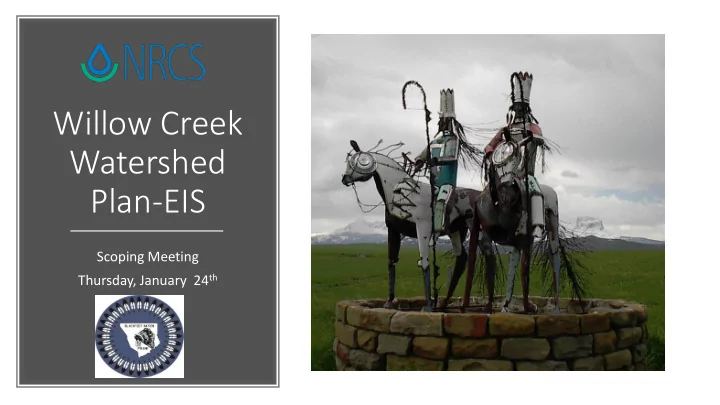

Willow Creek Watershed Plan-EIS Scoping Meeting Thursday, January 24 th
Purpose & Objectives of Scoping Project Background Flooding Issues/Overview Agenda Environmental Planning Factors Potential Flood Reduction Alternatives Next Steps Open Discussion
Purpose and Objectives of Scoping • Provide stakeholders with project overview • NEPA process • Determine extent and effects of flooding in Browning • Correlation to preliminary flood mapping • Discuss potential flood control alternatives to be examined • Identify environmental concerns within the watershed • Identify regulatory requirements and legislative issues • Provide opportunity for public input and questions “Scoping will ensure that all significant decision making factors are addressed and that unnecessary and extraneous studies are not undertaken”
Project Major Flooding in Browning Background • Major events – 1964, 1958, 1948, and 1920 • Annual flooding typical • Snowmelt, cloud burst, and ice jams contribute Past Efforts • 1969 Preliminary Investigation Report • 1973 Watershed Work Plan • 1975 Environmental Impact Statement Current Watershed Planning • Re-evaluate flooding effects • Alternative evaluation Project Purpose • Environmental analysis of alternatives The purpose of the project is to prevent or reduce damages caused by Willow • Preparation of a physically, environmentally, socially, Creek floodwater in Browning. and economically sound project plan prior to implementation of selected alternative.
Planning Schedule & Process P u b l i c & I n t e r a g e n c y I n p u t Oct 2018 – July 2019 Preliminary Investigations • Initial Environmental Evaluation • Hydrology and Hydraulics through Browning • Initial Alternative identification and conceptual layout • Preliminary Screening May 2019 – Jan 2020 Prepare Draft EIS • Environmental investigations and consultations • 30% drawings • Economic analysis • Select preferred alternative Sept 2019 – Feb 2020 Prepare 80% Design • Dam/Detention structure • Flood conveyance improvements • In-depth design factors considered Jan 2020 – March 2020 Prepare Final EIS • Incorporate comments • Record of Decision and Notice of Availability
Watershed Location
Historic Flooding Accounts
Preliminary Flood Mapping
Water Quality, Streams, & Wetlands Cultural & Historical Resources Fish & Wildlife Resources, Threatened & Endangered Species Environmental Economics/Socioeconomics Planning Infrastructure Factors Recreation uses Land Access Permissions & Land Ownership for Improvements Agriculture and Irrigation
Resource Concerns for Investigation Water Resources • Approved Water Resource Plans • Riparian Areas • Water Bodies • Wetlands
Resource Concerns for Investigation Biological Resources • Fish and Wildlife • Invasive Species • Fish Community • Culturally Significant Plants • Threatened and Endangered Species • Ecological Critical Areas • Migratory Birds and Wildlife Community
Resource Concerns for Investigation Soil Resources & Inventory • Broad understanding from WSS • Site specific investigations
Resource Concerns for In Investigation Human Resources • Cultural/Historical • Transportation Properties • Historical Sites • Natural Areas • Environmental • Scenic Areas Justice • Tribal Land • Recreational Acquisition Costs Opportunities • Land Use/Crop Inventory
Potential Flo lood Reduction Alt lternatives • Channel Improvements • Diversions • Storage • Combination of Measures
Preliminary Investigation • Initial scoping meetings • Initial alternative and environmental investigation • Initial alternative screening Watershed Draft Plan EIS Project Plan-EIS • Detailed environmental reviews • 30% design and analysis of selected alternatives (three) • 30% design public meeting • Preferred alternative selection Next Steps • Agency consultations • Draft EIS Public Meeting 80% Design of Selected Alternative Final Plan EIS • Final plan completion • Notice of Availability & Record of Decision
How to Provide Input or Obtain Additional Info • Project updates and news will be posted to the Tribal website, Facebook, and the Glacier Reporter • Provide your comments in this meeting • Complete a comment card • Visit, call, email, or write the project contacts: Tribal Sponsor: Responsible Federal Official: Consulting Engineer: Terry Tatsey Steve Becker, PE, COR Amy Darlinton, PE Blackfeet Tribal Business Council NRCS State Conservation Engineer NECI Project Manager 200 N. 34 th Street 640 All Chiefs Road 10 E. Babcock Street, Ste. 443 Browning, MT 59101 Bozeman, MT 59715 Billings, MT 59101 (406) 338-7522 (406) 587-6811 (406) 206-5248 ttatsey@blackfeetnation.com steve.becker@mt.usda.gov amy.darlinton@neciusa.com
Dis iscussion • Extent and effects of flooding in Browning? • Potential flood control alternatives to prevent flooding in Browning? • Environmental concerns? • Regulatory requirements and legislative issues? • Questions and answers?
Recommend
More recommend